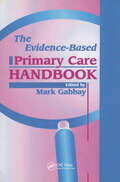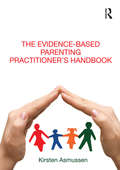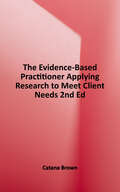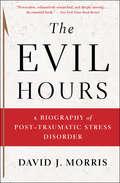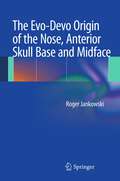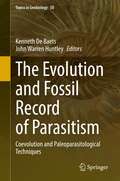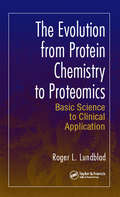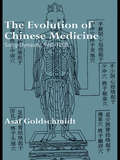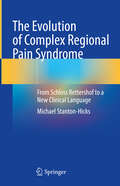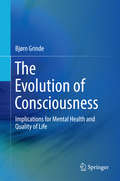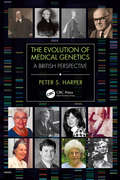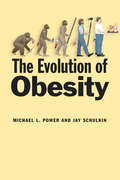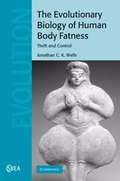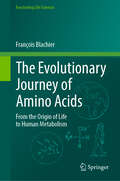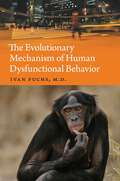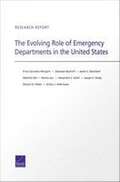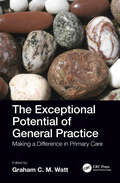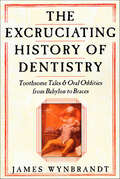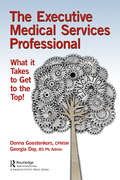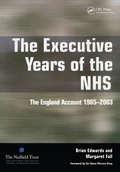- Table View
- List View
The Evidence-Based Primary Care Handbook
by Mark GabbayHere at last is a realistic and practical book that shows how evidence-based practice can be successfully applied in a primary care setting.The first section provides an introduction to the principles of evidence-based health care as they apply to primary care, and many other books on this subject stop right there. However, Section 3 practises what this first section preaches, by applying these tools to 15 common clinical problems in primary care, such as sore throat, asthma, urinary tract infections, low back pain and heart failure.In between, Section 2 focuses on topics of particular relevance to planners and to Primary Care Groups (PCGs), and includes chapters on commissioning, prescribing issues and health economics.The authors are all familiar with primary care as clinicians and/or researchers, and understand the reality of practising evidence-based medicine in primary care - for example, how to cope in the absence of 'best evidence', or how to search for evidence when time is very limited.GPs, primary care nurses, PCG managers, practice managers, community pharmacists and all other members of the primary health care team will find this book challenging, informative and relevant.
The Evidence-based Parenting Practitioner's Handbook
by Kirsten AsmussenThe Evidence-based Parenting Practitioner’s Handbook provides a comprehensive overview of the knowledge necessary to effectively deliver evidence-based parenting interventions within community and health settings. Using clear examples of how this knowledge can inform frontline work with parents, this practical handbook includes: an overview of the policy context underpinning evidence-based parenting work in the US, UK, Australia and Norway a discussion of how a robust evidence base is established and the ways in which practitioners can access information about good-quality research an overview of how research in the field of child development has contributed to the development of evidence-based parenting interventions an overview of how theories and research in the field of therapeutic practice have contributed to the development of evidence-based parenting interventions what research evidence suggests about the role of the practitioner in the delivery of evidence-based support outcome-focused methods for establishing the evidence base of new parenting interventions outcome-focused methods for commissioning evidence-based parenting services. Emphasizing the ways in which practitioners can evaluate and translate messages from research into applied work with parents and families, The Evidence-based Parenting Practitioner’s Handbook is suitable for all those involved in the delivery of evidence-based parenting support, including frontline practitioners, service managers, parenting commissioners, heads of children’s services and policy makers.
The Evidence-based Practitioner: Applying Research to Meet Client Needs
by Catana BrownPut the evidence to work for your clients. Become an effective evidence-based practitioner. <p><p>Master the knowledge and clinical decision-making skills you need to provide the very best care for your clients…based on the evidence. Step by step, you’ll learn how to find, read, understand, critique, and apply research evidence in practice. <p><p> Updated! Current evidence and the policies and practices of occupational therapy today <p><p>Expanded! Statistics coverage in three chapters: Descriptive Statistics: What They Tell You and How to Apply Them in Practice, Inferential Statistics: Tests of Difference, and Inferential Statistics for Relationship Questions <p><p>New & Expanded! Qualitative research coverage in two chapters: Qualitative Designs: Exploring the Lived Experience and a new chapter, Trustworthiness of Qualitative Studies New! Introduction of the critically appraised paper (CAP) as a concept with a new feature that walks students through completing one <p>Guiding principle of ‘Consuming vs. Conducting’ research <p>How to write a research question that addresses a relevant practice problem and then how to find, read, and apply evidence to address the question <p><p>Explanations of the different types of research and the methods and measurements used in each type, including their advantages and disadvantages. <p><p>‘From the Evidence,” excerpts with real data, abstracts, figures and tables from published research and coverage of how to decipher their meaning and apply them in practice <p><p>“Evidence in the Real World,” personal narratives from health professionals who demonstrate using evidence in their practice <p><p>“Understanding Statistics” boxes Worktext format with “Exercises” that encourage students to apply new concepts in the moment. <p><p>“Review Questions” at the end of each chapter <p><p>Answers to questions in the worktext at the end of each chapter
The Evil Hours: A Biography of Post-Traumatic Stress Disorder
by David J. Morris&“An essential book&” on PTSD, an all-too-common condition in both military veterans and civilians (The New York Times Book Review). Post-traumatic stress disorder afflicts as many as 30 percent of those who have experienced twenty-first-century combat—but it is not confined to soldiers. Countless ordinary Americans also suffer from PTSD, following incidences of abuse, crime, natural disasters, accidents, or other trauma—yet in many cases their symptoms are still shrouded in mystery, secrecy, and shame. This &“compulsively readable&” study takes an in-depth look at the subject (Los Angeles Times). Written by a war correspondent and former Marine with firsthand experience of this disorder, and drawing on interviews with individuals living with PTSD, it forays into the scientific, literary, and cultural history of the illness. Using a rich blend of reporting and memoir, The Evil Hours is a moving work that will speak not only to those with the condition and to their loved ones, but also to all of us struggling to make sense of an anxious and uncertain time.
The Evo-Devo Origin of the Nose, Anterior Skull Base and Midface
by Roger JankowskiThe phylontogenic theory proposes an original understanding of nose, sinus and midface formation and development by looking back in evolution for the first traces of the olfactory organ and then tracing its successive phyletic transformations to become part of the respiratory apparatus and finally the central point of human facial anatomy. Von Baer's, Darwin's, Haeckel's, Garstang's, Gould's and Buss' explorations of parallels between phylogeny and ontogeny help to trace the nose and midface story. The paradigm of existing parallels between ontogeny and phylogeny proves useful both in seeking to understand the holoprosencephalic spectrum of facial malformations (which represent radically different pathways of facial development after the life's tape has been started to run again) and in formulating hypotheses on chordate to vertebrate evolution. The phylontogenic theory leads to new medical hypotheses on nose and sinus diseases and opens the field of evolution and development-based medicine.
The Evolution and Fossil Record of Parasitism: Coevolution and Paleoparasitological Techniques (Topics in Geobiology #50)
by Kenneth De Baets John Warren HuntleyThis two-volume edited book highlights and reviews the potential of the fossil record to calibrate the origin and evolution of parasitism, and the techniques to understand the development of parasite-host associations and their relationships with environmental and ecological changes. The book deploys a broad and comprehensive approach, aimed at understanding the origins and developments of various parasite groups, in order to provide a wider evolutionary picture of parasitism as part of biodiversity. This is in contrast to most contributions by parasitologists in the literature that focus on circular lines of evidence, such as extrapolating from current host associations or distributions, to estimate constraints on the timing of the origin and evolution of various parasite groups. This approach is narrow and fails to provide the wider evolutionary picture of parasitism on, and as part of, biodiversity.Volume two focuses on the importance of direct host associations and host responses such as pathologies in the geological record to constrain the role of antagonistic interactions in driving the diversification and extinction of parasite-host relationships and disease. To better understand the impact on host populations, emphasis is given to arthropods, colonial metazoans, echinoderms, mollusks and vertebrates as hosts. In addition, novel techniques used to constrain interactions in deep time are discussed ranging from chemical and microscopic investigations of host remains, such as blood and coprolites, to the statistical inference of lateral transfer of transposons and host-parasite coevolutionary dynamics using molecular divergence time estimation.
The Evolution and Fossil Record of Parasitism: Identification and Macroevolution of Parasites (Topics in Geobiology #49)
by Kenneth De Baets John Warren HuntleyThis two-volume edited book highlights and reviews the potential of the fossil record to calibrate the origin and evolution of parasitism, and the techniques to understand the development of parasite-host associations and their relationships with environmental and ecological changes. The book deploys a broad and comprehensive approach, aimed at understanding the origins and developments of various parasite groups, in order to provide a wider evolutionary picture of parasitism as part of biodiversity. This is in contrast to most contributions by parasitologists in the literature that focus on circular lines of evidence, such as extrapolating from current host associations or distributions, to estimate constraints on the timing of the origin and evolution of various parasite groups. This approach is narrow and fails to provide the wider evolutionary picture of parasitism on, and as part of, biodiversity. Volume one focuses on identifying parasitism in the fossil record, and sheds light on the distribution and ecological importance of parasite-host interactions over time. In order to better understand the evolutionary history of parasites and their relationship with changes in the environment, emphasis is given to viruses, bacteria, protists and multicellular eukaryotes as parasites. Particular attention is given to fungi and metazoans such as bivalves, cnidarians, crustaceans, gastropods, helminths, insects, mites and ticks as parasites. Researchers, specifically evolutionary (paleo)biologists and parasitologists, interested in the evolutionary history of parasite-host interactions as well as students studying parasitism will find this book appealing.
The Evolution from Protein Chemistry to Proteomics: Basic Science to Clinical Application
by Roger L. LundbladLargely driven by major improvements in the analytical capability of mass spectrometry, proteomics is being applied to broader areas of experimental biology, ranging from oncology research to plant biology to environmental health. However, while it has already eclipsed solution protein chemistry as a discipline, it is still essentially an extension
The Evolution of Chinese Medicine: Song Dynasty, 960–1200 (Needham Research Institute Series)
by Asaf GoldschmidtThe history of Chinese medicine hinges on three major turning points: the formation of canonical theory in the Han dynasty; the transformation of medicine via the integration of earlier medical theories and practices in the Song dynasty; and the impact of Western medicine from the nineteenth century onwards. This book offers a comprehensive overview of the crucial second stage in the evolution of Chinese medicine by examining the changes in Chinese medicine during the pivotal era of the Song dynasty. Scholars often characterize the Song era as a time of change in every aspect of political, social, intellectual or economic life. More specifically it focuses on three narratives of change: the emperor's interest in medicine elevated the status of medicine in the eyes of the elite, leading to an increased involvement of intellectuals and the literary elite in medicine government officials systematically revised, printed, and promulgated earlier heterogeneous medical manuscripts belonging to various traditions the government established unique imperially sponsored medical institutions to handle public health and other aspects of medicine. As the first book to study the transformation medicine underwent during the Song period this volume will appeal to Sinologists and scholars of the history of medicine alike.
The Evolution of Complex Regional Pain Syndrome: From Schloss Rettershof to a New Clinical Language
by Michael Stanton-HicksLong before any written accounts of what has come to be described as Complex Regional Pain Syndrome (CRPS), this book entails a record that began in the department of Anesthesiology headed by Dr. John Bonica who during the Pacific arena of World War II came to manage thousands of wounded servicemen many of whom suffered from this complicated clinical entity often long after their original wounds had healed. Divided into two sections, the first provides a detailed chronology of the research and establishment of diagnostic criteria for CRPS. The second section provides an overview of how CRPS is evaluated and treated, along with the research that serves as its foundations.
The Evolution of Consciousness
by Bjørn GrindeThis book gives the reader an understanding of what consciousness is about, and of how to make conscious experiences more pleasant. It expands on a new theory that describes the evolutionary trajectory leading to conscious life forms. In short, the evidence suggests that consciousness first evolved some 300 million years ago as a consequence of the introduction of feelings. Feelings offer a strategy for making behavioural decisions. Besides playing a crucial role in the evolution of the human mind, they are a key factor in regard to mental health and quality of life. Fortunately, the human brain is plastic. By exploiting available options for modulating the mind, it is therefore possible to impact on what sort of experiences the brain serves. More specifically, you can strengthen the capacity for positive feelings and reduce the sway of negative feelings. The text covers biological, neurological, psychological, and philosophical aspects of the mind.
The Evolution of Global Child Rights: Protecting the Vulnerable (SpringerBriefs in Public Health)
by Kaitlyn Sacotte Brandon Tomlin Allison Judkins Luca BrunelliThis compact book celebrates the 100th anniversary of the Geneva Declaration of the Rights of the Child, a critical document that has shaped the relationship of adults with children worldwide. The document declares that all children must be fed, healed, protected, and given a safe place in which to develop fully. The brief:provides background information about the Geneva declaration and the related Convention on the Rights of the Child; discusses a child's rights to human dignity; and identifies local and global threats to children’s rights as well as potential safeguards against these threats. Among the topics covered:A Brief History of Children’s RightsRethinking Healthcare for Children – Pivot to Human DignityChildren’s Right to Health in the US Child Welfare System: A Case StudyGlobal Stakeholders in the Evolution of the Rights of the ChildThe Evolution of Global Child Rights: Protecting the Vulnerable is essential reading for anyone who works with or cares about children to understand the historic and current context of the rights and role of children within our society including pediatric healthcare professionals, policy makers, child welfare professionals, and other global stakeholders on child health.
The Evolution of Medical Genetics: A British Perspective
by Peter S. HarperThis informative new book presents an accessible account of the development of medical genetics over the past 70 years, one of the most important areas of 20th, and now 21st, century science and medicine. Based largely on the author’s personal involvement and career as a leader in the field over the last half century, both in the UK and internationally, it draws on his interest and involvement in documenting the history of medical genetics. Underpinning the content is a unique series of 100 recorded interviews undertaken by the author with key older workers in the field, the majority British, providing invaluable information going back to the very beginnings of human and medical genetics. Focusing principally on medically relevant areas of genetics rather than the underlying basic science and technological aspects, the book offers a fascinating insight for those working and training in the field of clinical or laboratory aspects of medical genetics, genomics and allied areas; it will also be of interest to historians of science and medicine and to workers in the social sciences who are increasingly attracted by the social and ethical challenges posed by modern medical genetics and genomics.
The Evolution of Obesity
by Jay Schulkin Michael L. PowerIn this sweeping exploration of the relatively recent obesity epidemic, Michael L. Power and Jay Schulkin probe evolutionary biology, history, physiology, and medical science to uncover the causes of our growing girth. The unexpected answer? Our own evolutionary success.For most of the past few million years, our evolutionary ancestors' survival depended on being able to consume as much as possible when food was available and to store the excess energy for periods when it was scarce. In the developed world today, high-calorie foods are readily obtainable, yet the propensity to store fat is part of our species' heritage, leaving an increasing number of the world's people vulnerable to obesity. In an environment of abundant food, we are anatomically, physiologically, metabolically, and behaviorally programmed in a way that makes it difficult for us to avoid gaining weight.Power and Schulkin’s engagingly argued book draws on popular examples and sound science to explain our expanding waistlines and to discuss the consequences of being overweight for different demographic groups. They review the various studies of human and animal fat use and storage, including those that examine fat deposition and metabolism in men and women; chronicle cultural differences in food procurement, preparation, and consumption; and consider the influence of sedentary occupations and lifestyles.A compelling and comprehensive examination of the causes and consequences of the obesity epidemic, The Evolution of Obesity offers fascinating insights into the question, Why are we getting fatter?
The Evolutionary Basis of Strabismus and Nystagmus in Children
by Michael C. BrodskyThis text is a comprehensive collection and discussion of scientific essays that define the pathogenesis of common forms of pediatric strabismus and nystagmus in terms of their common evolutionary mechanisms. The goal of this book is to assemble these essays, to provide a definitive source for current clinicians to use along with follow up comments to help direct future scientific research in the field of pediatric ophthalmology. This book includes 20 original essays written by Michael C. Brodsky which mechanistically explain and unify such enigmatic conditions such as infantile esotropia, latent nystagmus, primary oblique muscle overreaction action, dissociated vertical divergence, infantile nystagmus, and intermittent exotropia in terms of ancestral evolutionary reflexes which become expressed in different ways to generate these disorders. This collection of essays is poised to become a classic reference, providing the necessary neurological framework for contextualizing unique ocular motor disorder and understanding the evolutionary mechanisms responsible for their development in early childhood. Written with focused interest for pediatric ophthalmologists and neuro-ophthalmologists, this reference will also find audience with ophthalmologists, neurologists, evolutionary biologists, and neuroscientists.
The Evolutionary Biology of Human Body Fatness
by Jonathan C. K. WellsThis comprehensive synthesis of current medical and evolutionary literature addresses key questions about the role body fat plays in human biology. It explores how body energy stores are regulated, how they develop over the life-course, what biological functions they serve, and how they may have evolved. There is now substantial evidence that human adiposity is not merely a buffer against the threat of starvation, but is also a resource for meeting the energy costs of growth, reproduction and immune function. As such it may be considered as important in our species evolution as other traits such as bipedalism, large brains, and long life spans and developmental periods. Indeed, adiposity is integrally linked with these other traits, and with our capacity to colonise and inhabit diverse ecosystems. It is because human metabolism is so sensitive to environmental cues that manipulative economic forces are now generating the current obesity epidemic.
The Evolutionary Journey of Amino Acids: From the Origin of Life to Human Metabolism (Fascinating Life Sciences)
by François BlachierThis book takes readers on a journey from the very fundamental and chemical beginnings of amino acids on Earth to their role in human metabolism. It provides background on how amino acid metabolism has changed across the evolutionary tree and discusses their physico-chemical properties as well as their biochemical roles across various forms of life. Amino acids are emerging as key players in numerous physiological functions and are being increasingly recognized as playing a mechanistic role for the communication between the gut microbiota and the host in healthy state and in some pathophysiological situations. However, understanding these associations requires a multidisciplinary approach, combining chemistry, biochemistry, physiology, nutrition, molecular/cellular biology and microbiology. This book aims to describe the science behind amino acids from their first appearance and evolutionary significance, all the way through the tree of life to humans, and then to consider how gut microbial amino acid metabolism regulates human physiology and risk in some chronic diseases. It covers key concepts such as the characteristics of different amino acids found in living organisms, their existence in the pre-living world, and their vital roles in metabolism and physiology. It also explores intriguing questions about microbial communication and the effect of amino acid-derived microbial metabolites on mammalian cells. With this multidisciplinary approach and accessible structure, this book will appeal not only to students and researchers with a background in biochemistry and related fields, but also to non-specialists with an interest in the foundations of life at the intersection of evolutionary biology and metabolism.
The Evolutionary Mechanism of Human Dysfunctional Behavior: Relaxation of Natural Selection Pressures throughout Human Evolution, Excessive Diversification of the Inherited Predispositions Underlying Behavior, and Their Relevance to Mental Disorders
by Ivan FuchsWhy is humanity by far the most successful animal in the animal kingdom, but when it comes to survival of the fittest, we pull against the impulse toward natural selection? Unique among vertebrates, humans develop and practice varied forms of dysfunctional or maladaptive behavior, the graver of which are categorized as mental disorders, which doesn&’t sustain our species. Dr. Ivan Fuchs explains why this is the case, setting his discussion within the fields of psychiatry, evolutionary biology, and genetics, marshalling a wide-range research to make a compelling case. In this work, Dr. Ivan Fuchs provides his theory on human dysfunctional behavior rooted in Darwinian evolutionary thinking. His theory includes: 1. An attempt to identify the basic evolutionary mechanism that leads to dysfunctional or maladaptive behavior that is increasing in human populations. He proposes that this mechanism consists of progressive relaxation of selection pressures originating in the natural environment as a result of the technological and cultural development in human civilization. These developments protect against many natural inconveniences and dangers such as harmful weather conditions; scarce or unreliable food supplies; cruel, even deadly competition for life-sustaining or reproductive resources; danger of predation, and so on. The relaxation of natural selection pressures leads to excessive diversification of innate predispositions that, due to the complexities of social coexistence, has both far-reaching beneficial, as well as harmful, consequences. 2. Dr. Fuchs deals primarily with severe forms of dysfunctional behavior (categorized as mental disorders), pinpointing those genetically based behavioral complexes which predispose humans to anxiety, affective and personality disorders, paranoia, and schizophrenia. 3. Dr. Fuchs also makes clear that the above innate predispositions cannot lead by themselves to the whole clinical picture of diagnosable mental disorder categories. In order for full-blown clinical symptomatology to develop, the innate predisposition has to interact with influences after childbirth, first of all, learning. Consequently, psychiatric understanding and research has to distinguish sharply between those mental (brain) structures and functions which constitute the innate predisposition to a certain mental disorder versus those ones involved secondarily during the lifespan. This consideration is detailed in the case of schizophrenia spectrum of disorders. The above theoretical considerations have important therapeutic, preventive and research implications.
The Evolving Landscape of Liver Cirrhosis Management
by Hitoshi Yoshiji Kosuke KajiThis book comprehensively covers the latest developments in the diagnosis and treatment of liver cirrhosis, including molecular mechanisms and therapeutic strategies. It elaborates on and explores the relation between chronic liver disease (CLD) and its causes, including viral hepatitis, steatohepatitis, autoimmune liver diseases and/or inherited liver diseases, and sustained liver injury. Furthermore, it discusses various complications such as hepatic encephalopathy, ascites, sarcopenia, esophagogastric varices, muscle cramps and pruritus, and the fact that it frequently leads to the development of hepatocellular carcinoma. CLD is becoming a growing issue with substantial effects on public health, and Evolving Landscape in Management of Liver Cirrhosis provides scholars in gastroenterology and hepatology with invaluable insights. At the same time, it is a valuable resource for clinicians specializing in gastroenterology and hepatology as well as for researchers who are curious about new research on liver disease.
The Evolving Role of Emergency Departments in the United States
by Arthur L. Kellermann Edward N. Okeke Kristy Gonzalez Morganti Sebastian Bauhoff Janice C. Blanchard Mahshid Abir Neema Iyer Alexandria C. Smith Joseph V. VeselyThis report explores the evolving role that hospital emergency departments play in the U. S. health care system. EDs evaluate and manage complex and high-acuity patients, are the major point of entry to inpatient care, and serve as â#128;#156;the safety net of the safety netâ#128;#157; for patients who cannot get care elsewhere. The report examines the role that EDs may come to play in either contributing to or reducing the rising costs of health care.
The Exceptional Potential of General Practice: Making a Difference in Primary Care
by Graham WattThis innovative and timely book draws on pioneering precedents, basic principles, current examples and international experience to capture the narratives, examples and ideas that underlie and demonstrate the exceptional potential of general practice: <P><P>"If health care is not at is best where it is needed most, health inequalities will widen." <P><P>"The unworried unwell are not hard to reach but they are easy to ignore and are often ignored." <P><P>"With patient contact, population coverage, continuity, coordination, flexibility, long term relationships and trust, general practices are the natural hubs of local health systems." <P><P>"… practitioners … are not only scientists but also responsible citizens and if they did not raise their voice who else should?" <P><P>Written for family doctors looking to strengthen local collaboration, it brings together the traditional strengths of consultations, caring, continuity, coordination and coverage with the current and future challenges of building capacity, community, creativity, consistency, collegiality and campaigning. It highlights the critical importance of working with patients, maximising the use of serial encounters, integrating care, joint working between practices, social prescribing, community development and advocacy based on patient and practitioner experience. <P><P>Drawing on the highly-regarded work of Deep End GPs serving the poorest communities in Scotland ̶ www.gla.ac.uk/deepend ̶ the book is an invaluable handbook for all primary care doctors, irrespective of health care system or country, seeking to provide unconditional continuity of personalised care for all patients, whatever problem or combination of problems a patient may have.
The Exceptions: Nancy Hopkins and the fight for women in science
by Kate Zernike&‘Outstanding&’ Bonnie Garmus, bestselling author of Lessons in ChemistryThe remarkable untold story of how a group of sixteen determined women used the power of the collective and the tools of science to inspire ongoing radical change. This is a triumphant account of progress, whilst reminding us that further action is needed. These women scientists entered the work force in the 1960s during a push for affirmative action. Embarking on their careers they thought that discrimination against women was a thing of the past and that science was a pure meritocracy. Women were marginalized and minimized, especially as they grew older, their contributions stolen and erased. Written by the Pulitzer Prize-winning journalist who broke the story in 1999 for The Boston Globe, when the Massachusetts Institute of Technology made the astonishing admission that it discriminated against women on its faculty, The Exceptions is an intimate narrative which centres on Nancy Hopkins – a surprisingly reluctant feminist who became a hero to two generations of women in science. In uncovering an erased history, we are finally introduced to the hidden scientists who paved the way for collective change.
The Excruciating History of Dentistry: Toothsome Tales & Oral Oddities from Babylon to Braces
by James WynbrandtAn “entertaining history” of the practice of dentistry that will remind you how lucky you are to live in the modern era (Publishers Weekly).For those on both sides of the dreaded dentist’s chair, James Wynbrandt has written a witty, colorful, and richly informative history of the art and science of dentistry. To all of those dental patients whose whine rises in tandem with that of the drill, take note: You would do well to stifle your terror and instead offer thanks to Apollonia, the patron saint of toothache sufferers, that you face only fleeting discomfort rather than the disfiguring distress or slow agonizing death oft meted out by dental-care providers of the past. The transition from yesterday’s ignorance, misapprehension, and superstition to the enlightened and nerve-deadened protocols of today has been a long, slow, and very painful process—as shown by such facts as:*Among the toothache remedies favored by Pierre Fauchard, the father of dentistry, was rinsing the mouth liberally with one’s own urine.*George Washington never had wooden teeth. However, his chronic dental problems may have impacted the outcome of the American Revolution.*Soldiers in the Civil War needed at least two opposing front teeth to rip open powder envelopes. Some men had their front teeth extracted to avoid service.*Teeth were harvested from as many as fifty thousand corpses after the Battle of Waterloo, a huge crop later used for dentures and transplants that became known as “Waterloo Teeth.”“You’ll gain a great deal of dental knowledge, acquired quite painlessly.” —The New York Times Book Review“Just the thing you need to get through your next oral probing.” —Entertainment Weekly“A breezy romp . . . While sensitive dentists may wince at having their profession’s rough-and-tumble past revealed, dental patients are more likely to feel relief at having been born in the modern era of dentistry. Both groups are in for a good laugh.” —Kirkus Reviews
The Executive Medical Services Professional: What It Takes to Get to the Top!
by Donna Goestenkors Georgia DayMedical Services Professionals (MSPs) hold a unique place in the healthcare industry. Medical Staff leaders, practitioners and providers rely on MSPs to ensure qualitative regulatory compliance, performance improvement, accreditation, credentialing and governance for physicians, practitioners, and other healthcare providers. MSPs ensure the design, implementation, and maintenance of current industry practices to promote quality patient care. Their roles are rapidly changing due to competition, increased government influence, and vast changes in technology that demand for service delivery improvements worldwide. The successful MSP will require a formal professional development plan, comprised of skills and knowledge for both personal and career choices as the industry moves into the future. This book is presented in an easy to read format and contains a series of building blocks, "points" to navigate career progression logically. Each point highlights solutions for MSPs to test and apply with real-life stories interspersed to illustrate points. This book contains a helpful glossary, sample job descriptions, and terms specific to the MSP.
The Executive Years of the NHS: The England Account 1985-2003
by Brian Edwards Margaret FallA guide to clinical effectiveness and governance, this second edition includes clinical governance issues. It aims to increase awareness of, and skills in, an evidence-based approach to health care, and there is advice on collecting, evaluating, interpreting and applying evidence.
